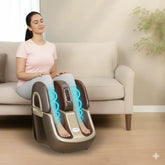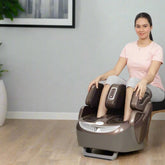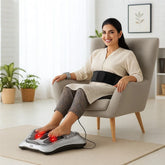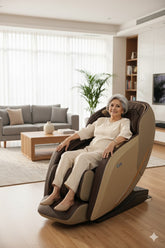Do massage guns really work?
Introduction :
Embarking on a quest to uncover the truths and myths surrounding massage guns, one can't help but be intrigued by the rising popularity of these handheld devices that have taken the wellness industry by storm. With a society that increasingly leans towards proactive health management and innovative self-care methods, massage guns have emerged as a symbol of modern wellness technology. These devices, often sleek and portable, promise to deliver deep tissue massages that rival those of professional therapists, all from the comfort of one's home. The allure of such a proposition is undeniable, but it begs the question: Do massage guns really work, or are they just a fleeting trend in the vast wellness landscape?
This exploration into the efficacy and potential benefits of massage guns is not just a journey through the mechanical workings of these devices but also an investigation into their impact on our health and wellbeing. As we delve deeper, we aim to shed light on various aspects of massage guns, including their appropriateness for general use, their effectiveness in alleviating back pain, and the specific areas of the body they target most effectively.
Do massage guns really work?
Massage guns have become a popular tool for muscle recovery, pain relief, and improving overall wellness, but do they really work as promised? To answer this question, it's essential to delve into the mechanics of how massage guns operate and what science says about their effectiveness.
The Mechanism Behind Massage Guns
Massage guns use percussive or vibration therapy to target deep tissues with rapid, repetitive strokes. This action is designed to mimic the benefits of a deep tissue massage, which includes loosening tight muscles, increasing blood flow, and reducing muscle soreness and inflammation. The theory is that the forceful percussion stimulates deep muscle fibers, promoting faster recovery by enhancing blood circulation and distributing nutrients to the muscle tissue, thus aiding in the healing process.
Scientific Evidence
Research on the efficacy of massage guns and percussive therapy is still evolving, but early studies are promising. A study published in the Journal of Clinical and Diagnostic Research found that vibration therapy, similar to what massage guns offer, can improve muscle strength, flexibility, and reduce soreness after workouts. Another study in the Journal of Sports Science & Medicine suggests that vibratory therapy can be effective in preventing delayed onset muscle soreness (DOMS).
However, it's crucial to note that most studies focus on vibration therapy in a broad sense, and specific research on massage guns is relatively limited. The existing studies offer a general endorsement of the principles behind massage guns but don't necessarily validate every claim made by manufacturers.
Anecdotal Evidence
Beyond scientific research, there is a wealth of anecdotal evidence supporting the effectiveness of massage guns. Many athletes, physical therapists, and fitness enthusiasts report positive results, including reduced recovery time, improved mobility, and decreased muscle tension. The personal experiences of individuals who find significant relief and benefit from using massage guns cannot be overlooked, even as we await more rigorous scientific validation.
Considerations and Cautions
While massage guns appear to work for many people, they are not a one-size-fits-all solution. The effectiveness can vary based on individual pain tolerance, muscle condition, and technique used. Moreover, improper use of a massage gun can lead to bruising, increased pain, or injury, especially if used on high settings for extended periods or on sensitive areas near bones or nerves.
Is it OK to use a massage gun?
Using a massage gun can be a beneficial addition to one's wellness routine, offering convenience and potential relief from muscle soreness, tightness, and fatigue. However, as with any therapeutic tool, it's essential to understand when and how it's appropriate to use one to ensure safety and effectiveness.
When It's Beneficial
- Muscle Recovery: For athletes or fitness enthusiasts, massage guns can aid in recovery after workouts by increasing blood flow to the targeted muscles, helping to reduce delayed onset muscle soreness (DOMS).
- Pain Relief: Individuals suffering from muscle stiffness and pain may find relief through the use of massage guns. The percussion therapy helps to break up knots and reduce tension in the muscles.
- Increasing Flexibility: By loosening tight muscles, massage guns can help improve flexibility and range of motion, which is beneficial for both athletes and those with sedentary lifestyles.
- Stress Reduction: The massage can also have a soothing effect, reducing stress and promoting relaxation, much like traditional massage therapies.
Precautions and Contraindications
While massage guns are generally safe for most people, there are certain conditions and scenarios where caution should be exercised or their use should be avoided:
- Over Injured Areas: Directly applying a massage gun to injured tissues, open wounds, or areas of inflammation can worsen the condition. It's crucial to allow injuries to heal or consult with a healthcare professional before using a massage gun on these areas.
- Blood Clot Risks: Individuals with a history of blood clots should avoid using massage guns, especially on areas prone to clot formation, without first consulting a doctor.
- Pregnancy: Pregnant women should exercise caution and consult with a healthcare provider before using a massage gun, particularly around the lower back and pelvic areas.
- Neurological Disorders: Those with conditions affecting the nervous system should seek medical advice before using a massage gun to avoid potential complications.
- Bone Fractures and Osteoporosis: Using a massage gun on or near areas with bone fractures or osteoporosis can lead to further damage and should be avoided.
Best Practices for Use
To maximize the benefits and minimize risks, consider the following guidelines when using a massage gun:
- Start Slowly: Begin with the lowest setting to assess your tolerance and avoid starting on high intensity, which can be too aggressive for sensitive muscles.
- Short Sessions: Limit the use to short sessions (1-2 minutes per muscle group) to prevent overstimulation and potential muscle damage.
- Avoid Sensitive Areas: Steer clear of using the massage gun on areas with thin muscle coverage over bones or near joints to prevent discomfort and injury.
- Listen to Your Body: Pay attention to how your body responds. Discontinue use if you experience pain or discomfort beyond mild soreness.
Is massage gun good for back pain?
Massage guns can be effective for relieving back pain, provided they are used correctly and judiciously. Back pain is a common ailment that affects a significant portion of the population, stemming from a variety of causes such as muscle tension, poor posture, overexertion, or underlying health conditions. Massage guns, through their percussive therapy mechanism, offer a non-invasive way to address some of the muscular components of back pain.
How Massage Guns Can Help with Back Pain
-
Muscle Relaxation and Tension Relief: Massage guns work by delivering rapid bursts of pressure into the muscle tissue, which can help relax tight muscles and ease tension. This is particularly beneficial for lower back pain caused by stiff or overworked muscles.
-
Increased Blood Flow: The percussive action of massage guns increases blood circulation to the targeted area. Enhanced blood flow brings more oxygen and nutrients to the muscles, aiding in the repair and recovery process, which can contribute to pain relief.
-
Reduction in Lactic Acid Buildup: Physical activity or prolonged periods of inactivity can lead to the accumulation of lactic acid in the muscles, contributing to soreness and discomfort. Massage guns can help disperse these accumulations, alleviating discomfort associated with lactic acid buildup.
-
Improvement in Flexibility and Range of Motion: Regular use of massage guns on the back can lead to an improvement in flexibility and range of motion. This can help reduce the risk of strains and injuries that might contribute to back pain.
Considerations for Using Massage Guns for Back Pain
-
Avoid Direct Application on Spine: It's crucial to avoid using the massage gun directly on the spine or bony prominences. Focus on the muscle tissue surrounding these areas to prevent injury.
-
Consult Healthcare Providers for Chronic or Severe Pain: If your back pain is chronic or severe, it's important to consult with a healthcare provider to identify the underlying cause. A massage gun can be part of a broader treatment plan but should not replace professional medical advice.
-
Proper Technique: For effective relief, it's important to use the massage gun properly. This includes choosing the right attachment, adjusting the speed to your comfort level, and using the device at the right angle to reach deep tissues without causing discomfort.
-
Listen to Your Body: Everyone's pain tolerance and condition are different. Pay attention to how your body responds to the treatment. If using the massage gun increases pain or discomfort, discontinue use and seek advice from a healthcare professional.
What areas do massage guns target?
Massage guns are versatile tools designed to target a wide range of muscle groups, providing relief from tension, promoting recovery, and enhancing overall muscle health. They are especially favored for their ability to reach deep tissues that are difficult to stimulate through traditional massage techniques alone. Here are the primary areas that massage guns commonly target:
- Legs: Including the quadriceps, hamstrings, calves, and shins. Massage guns can help relieve soreness and tightness resulting from running, cycling, or other leg-intensive activities.
- Back: Both the upper and lower back muscles can benefit from massage gun therapy, aiding in the relief of tension and pain. It's important to avoid direct application on the spine and instead focus on the surrounding muscles.
- Shoulders and Neck: These areas often harbor tension from poor posture, especially in people who work at desks or frequently use mobile devices. A massage gun can help alleviate this tension, improving mobility and reducing pain.
- Arms: Including the biceps, triceps, and forearms, which can become tight from exercises like weightlifting or sports, as well as everyday activities like typing or carrying heavy objects.
- Glutes: Tight gluteal muscles can contribute to lower back pain and discomfort. Massage guns can target these muscles, promoting relaxation and reducing pain.
Specific Concerns and Conditions
- Muscle Recovery: Athletes and fitness enthusiasts use massage guns to target muscles that are sore from workouts, helping to accelerate recovery by increasing blood flow and reducing lactic acid buildup.
- Pain Relief: For those suffering from conditions like DOMS (delayed onset muscle soreness) or general muscle tension, massage guns can provide targeted relief.
- Injury Rehabilitation: Under the guidance of a healthcare professional, massage guns can be used as part of a rehabilitation program for injuries, helping to gently stimulate muscles and improve circulation without overexertion.
Tips for Targeting Areas
- Use Appropriate Attachments: Most massage guns come with a variety of attachments designed for specific areas. For instance, a flat head is great for larger muscle groups, while a bullet head can target trigger points more effectively.
- Adjust the Speed: Start with a lower speed setting and gradually increase to find what's comfortable and effective for the targeted area. Some areas may require gentler treatment, especially if they're near bones or sensitive.
- Proper Technique: Ensure you're using the massage gun at the correct angle and moving it slowly across the muscle group to avoid bruising and maximize effectiveness.
Conclusion on do massage guns really work :
In conclusion, the rise of massage guns in the realm of wellness and fitness has sparked both enthusiasm and skepticism. These handheld devices, designed to deliver deep tissue massages through percussive therapy, claim to offer a range of benefits including muscle recovery, pain relief, increased blood flow, and improved flexibility. Based on the current understanding from scientific research, anecdotal evidence, and the principles of percussive therapy, it can be said that massage guns do work for many people, offering a convenient and effective way to alleviate muscle soreness, enhance recovery, and promote overall well-being.
Scientific studies, though still limited in number, suggest that the mechanisms behind massage guns—increasing blood circulation, reducing muscle stiffness, and enhancing tissue repair—are effective in improving muscle function and reducing soreness. Anecdotal evidence from athletes, physical therapists, and fitness enthusiasts further supports these findings, with many reporting positive outcomes in their muscle health and recovery processes.
However, it's crucial to approach the use of massage guns with a balanced perspective. They are not a panacea for all muscle-related ailments and should be used as part of a broader wellness strategy that includes proper exercise, nutrition, and rest. The effectiveness of massage guns can vary depending on the individual's specific conditions, usage methods, and overall health.
Safety should always be a priority when using massage guns. Users should educate themselves on proper techniques, avoid using the device on injured or sensitive areas without professional guidance, and heed their body's response to avoid potential harm.
In summary, while more comprehensive research is needed to fully understand the extent of their benefits, the evidence so far indicates that massage guns can indeed be a valuable tool for enhancing muscle recovery, relieving pain, and improving physical performance when used correctly. As with any health and wellness tool, individuals should consider their personal health conditions, consult with healthcare professionals as needed, and use massage guns as one component of a holistic approach to maintaining and improving their physical well-being.











